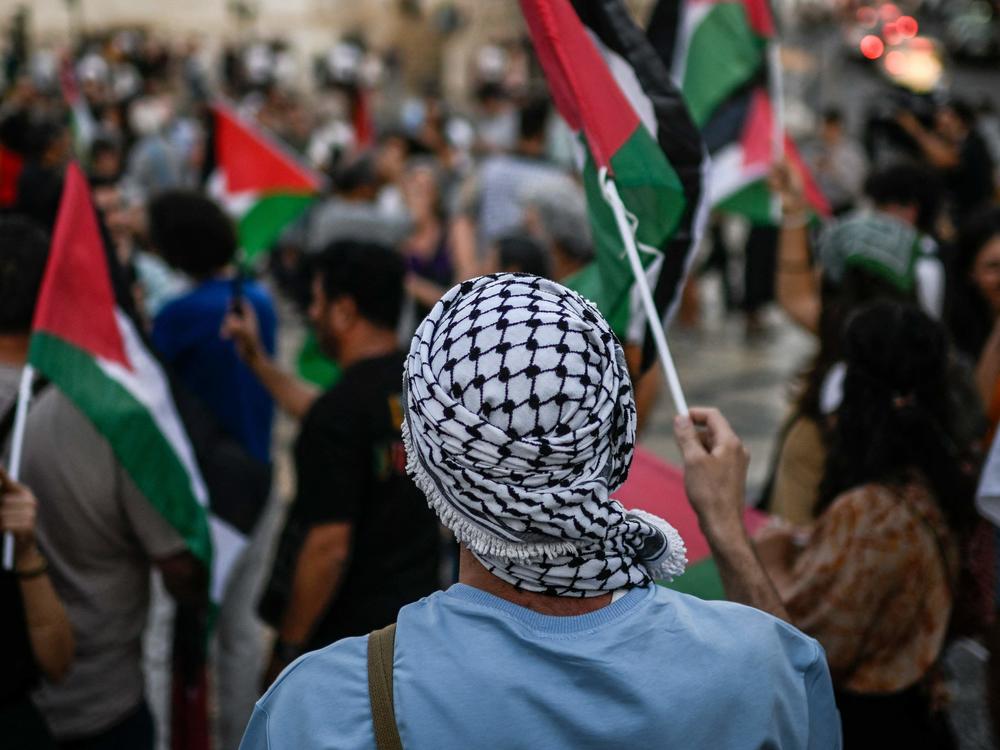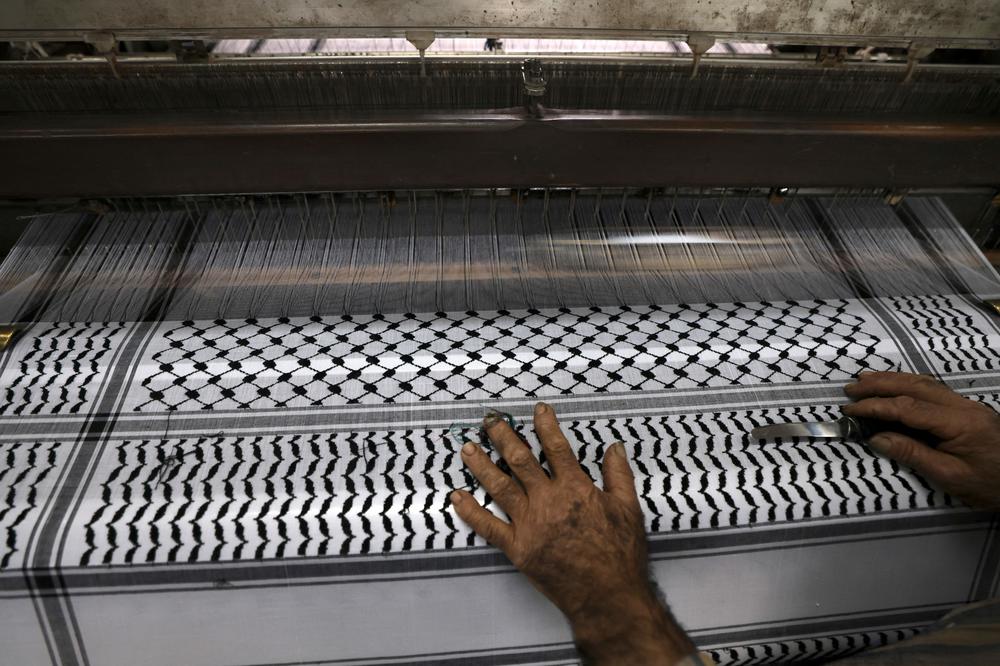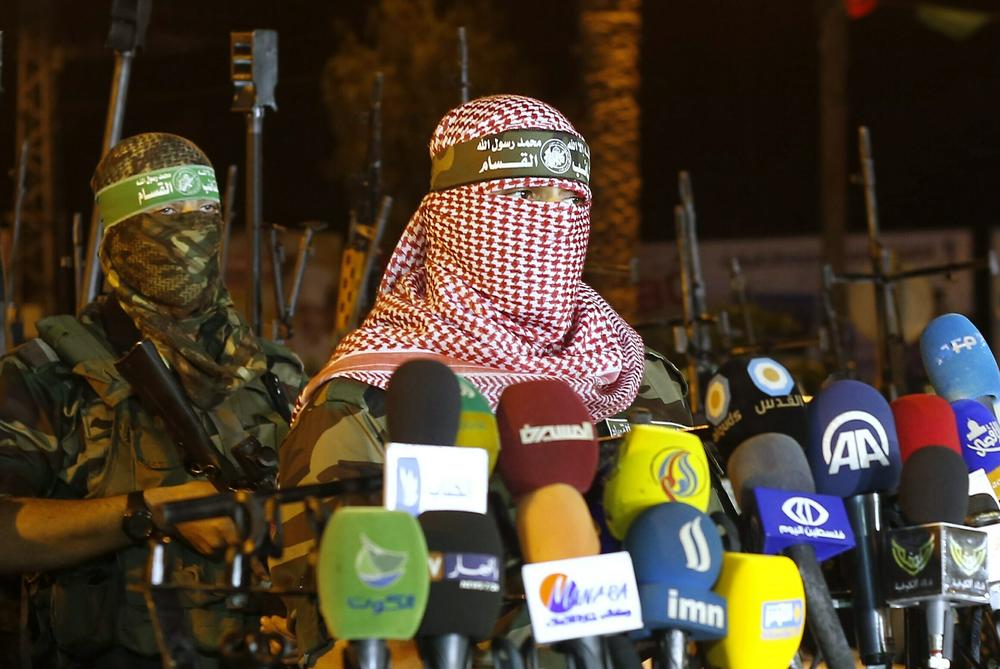Section Branding
Header Content
What is a keffiyeh, who wears it, and how did it become a symbol for Palestinians?
Primary Content
Ashish Prashar was at a Brooklyn playground with his 18-month-old son in early November when he said a woman approached him and asked if he supported Hamas.
She got angrier and angrier, Prashar said, and the situation escalated.
In a recording of part of the interaction posted on social media, the woman, Hadasa Bozakkaravani, can be seen yelling and throwing things at Prashar, saying "you and your son go away." She has been charged with a number of hate crimes and plead not guilty when arraigned last month, according to court records. Bozakkaravani's lawyer did not respond to NPR's request for comment.
Prashar is not Palestinian, or Muslim, or Arab. He's British-Punjabi. But he was wearing a scarf that's become synonymous with Palestinians: A black and white keffiyeh.
Since the Hamas attack on Israel on Oct. 7 and Israel's bombardment of Gaza in response, the keffiyeh has drawn increased attention in the United States. Over the Thanksgiving weekend, three students of Palestinian descent were shot in Vermont — two of them were wearing the keffiyeh.
So what is a keffiyeh, who wears it, and how did it become a symbol for Palestinians?
What is a keffiyeh and what does it mean?
First, the basics.
The keffiyeh, also known as a hatta, is a traditional Arab headdress. Historically, it was worn by nomadic communities — or Bedouins — in historic Palestine. It's typically made of cotton and adorned with distinctive woven patterns. It comes in a variety of colors, though over the last century, the black and white one has become synonymous with Palestinians.
Some say patterns on the keffiyeh symbolize different aspects of Palestinian life: the bold black stripes on the edges symbolize the historical trade routes that used to go through Palestine; the fishnet-like design represents the Palestinians' ties to the Mediterranean Sea; and the curvy lines resemble olive trees, a major point of pride for Palestinians.
Though none of these claims can be backed up by historical evidence, over the past 10 years they've become embraced by Palestinians in the diaspora to be the meaning behind their keffiyeh's patterns.
"In my research and in my experience, often interacting with the keffiyeh from the 19th century, I often see a variety of colors," said Wafa Ghnaim, a Palestinian dress expert and a senior research fellow at the Metropolitan Museum of Art. "I see white-black like we see today, but also green. And sometimes I see threads of gold and red. It's really not until the 1930s that we start to see the keffiyeh change in meaning, not by the patterning that's in the scarf, but in its use."
Listen to All Things Considered each day here or on your local member station for more stories like this.
How has its meaning changed over time?
Until the 1920s, the keffiyeh was almost exclusively worn by Bedouin men, according to Ghnaim, and it was simply a way to identify nomadic men in historic Palestine from villagers, fellaheen, and town people.
According to Ghnaim, the first time we see the keffiyeh used as a political statement was during the Arab Revolt in Palestine in 1936 — an uprising against British rule that included demands for independence and an end to Jewish immigration.
At that time, the majority of the armed resistance was taking place in the villages, and the fighters used the keffiyeh to hide their features — helping it to become associated with the revolution. The revolution's leaders issued an order for men to wear the keffiyeh to express solidarity with the revolutionaries and so that the British could not distinguish the fighters from others.
In the 1960s, it became associated with Palestinian nationalism, particularly due to its adoption by leaders like Yasser Arafat. During this era, it represented solidarity and resistance against the Israeli occupation.
The apocryphal story among many Palestinians is that Arafat folded his keffiyeh in a way that reminded him of the Dome of the Rock in Jerusalem, and let the side panel drape in a way that resembled the historic map of Palestine.
Around the same time, the fedayeen — a term used to describe nationalist Palestinian militants — conducted guerilla operations while wearing the keffiyeh.
Other prominent Palestinians also donned the keffiyeh during that time, included Leila Khaled — who was involved in two plane hijackings in 1969 and 1970 as part of the Popular Front for the Liberation of Palestine.
"That's when we start to see women wearing the black and white keffiyeh, specifically Palestinian women," Ghnaim said. "So it wasn't just a male headdress anymore. By the 1960s, it became something worn by Palestinian women as well around their neck."
What does it mean now?
It depends who you ask.
For many Palestinians, it symbolizes their yearning for freedom and serves a nod to their history. For some non-Palestinians, it's a show of solidarity.
Recently, it has also been associated with the Hamas spokesperson known only by his nom de guerre, Abu Obeida. He became known as al-mulatham or the "masked one" because his face is always covered by a red and white keffiyeh that shows only his eyes.
His voice — and his keffiyeh — have become familiar in Arab households during this current conflict. He has praised the Oct. 7 attack that the Israeli government says killed 1,200, including women and children, as a victory for the Palestinian cause. He has maintained that stance, even as the Israeli response has killed more than 15,000 people in Gaza, according to the Gaza Health Ministry, which includes mostly women and children.
There is a long history of Palestinians wearing the keffiyeh to cover their faces, according to Ghnaim, not just as a form of activism but also to protect them from tear gas or from identification during protests.
For others, like queer Palestinian content creator Rand Jitan, who lives in New York, the keffiyeh has no connection to a specific group or organization — but, rather, to her heritage. Her keffiyeh was a gift from her therapist, and she said she wears it whenever she can and in a variety of ways: draped around her neck, wrapped around her head, and sometimes even as a blanket when she goes to the beach or the park.
"I put it on and it gives me a feeling," she said. "How powerful is that? Like years and years, these histories that we have in a f---ing cloth. It's crazy. It's awesome. It's incredible. It's beautiful."
Jitan styles her keffiyeh in different ways, which she said garners different reactions from people.
"Sometimes when I wear it on my head and it kind of looks like a hijab — or it looks like what somebody might see on TV and assume to be a 'terrorist' — like, I feel even more empowered doing that," Jitan said. "I'm not looking for a reaction, I'm looking for people to internally challenge themselves. And I like that."
For others, however, like Prashar and the students in Vermont, there is a fear that the keffiyeh can provoke a violent reaction. Ghnaim sees this violence as a reflection of how dehumanized Palestinians and their cause for independence have become.
"The keffiyeh and our clothing will always reflect our current context and our identity," she said. "This is the history of Palestinian dress. We always express identity through our dress. And I think right now we see that, also, it seems people reflect their own beliefs and judgements of our identity onto our dress."
For Prashar, the confrontation in the Brooklyn playground has made him more defiant.
"It means that I stand in solidarity with all oppressed people, especially Palestinians," he said of wearing the keffiyeh. "I understand that it means a lot of different things to a lot of people. But for me, it's showing that I see them, I'm there for them."
"I'm never taking it off."
Copyright 2023 NPR. To see more, visit https://www.npr.org.




